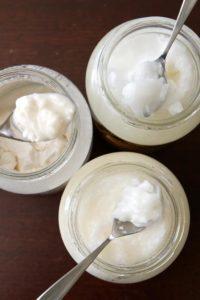It seems everyone’s talking about oil pulling these days – from mommy bloggers to fashionistas to the Huffington Post and plenty more in between. But what is it? And why is it? And why have Dr. Glaros and many of us here in the office happily taken up this ancient Ayurvedic practice?
What Is Oil Pulling Anyway?
 Basically, oil pulling involves gently swishing oil in the mouth, through and over the teeth, for 15 minutes or so. It’s been used as a traditional folk remedy for thousands of years to strengthen teeth, gums and jaws, as well as prevent tooth decay, bad breath and gum disease.
Basically, oil pulling involves gently swishing oil in the mouth, through and over the teeth, for 15 minutes or so. It’s been used as a traditional folk remedy for thousands of years to strengthen teeth, gums and jaws, as well as prevent tooth decay, bad breath and gum disease.
There are a couple of theories about how oil pulling works. Most often, you hear that the oil “pulls” bacteria from the mouth into the oil – a theory rooted in the chemical principle that “like dissolves like.” This suggests that oil is able to cut through and break up the biofilm (“plaque”) on your teeth without damaging the enamel. It’s also believed that the oil’s low viscosity keeps microbes from sticking to the teeth, which in turn makes it harder for them to recolonize.
Many swear by oil pulling as a way to heal and detoxify the body even further, offering relief from a number of chronic illness. Skeptics beg to differ. As usual, the truth is somewhere in the middle. Our concern isn’t with those health claims, though – just oil pulling’s role in dental hygiene.
For there is, in fact, some good research out there supporting its ability control oral microbes that would otherwise contribute to disease. For instance, a 2011 study in the Journal of Indian Society of Pedodontics and Preventive Dentistry reported oil pulling to be as effective as chlorhexidine – an antimicrobial mouthwash – in relieving halitosis. An earlier study headed by the same lead author reached a similar conclusion. Both the oil pulling and chlorhexidine groups had lower counts of S. mutans – a key bacterium involved in tooth decay – but only the oil pulling group showed significant reduction at all four testing times; chlorhexidine, just the first two.
“Oil pulling,” concluded the authors, “can be used as an effective preventive adjunct in maintaining and improving oral health.”
It’s worth noting, too, that while chlorhexidine is infamous for staining the teeth, oil pulling has a demonstrated tendency to whiten them.
How to Practice Oil Pulling
Note: Some people report a detox effect for the first few days of oil pulling, including mild congestion, headache and mucus drainage, among other effects. If you are pregnant, breastfeeding, or have braces or caps, consult your dentist before you start oil pulling.
- Choose your oil. Most studies to date have used sesame seed oil, but others recommend coconut oil – which Dr. Glaros likes also for its richness in medium-chain fatty acids and lauric acid, both of which have wide-ranging health benefits. Whichever oil you use, make sure it is raw, unrefined and organic.
- First thing in the morning – before you eat or drink anything or brush your teeth – put 1 to 2 tablespoons of oil in your mouth. If you use coconut oil – which is solid at room temperature but melts quickly – this may feel a little weird at first, but that feeling soon fades.
- Swish the oil for 15 to 20 minutes. This is the time it takes for the oil to cut through the biofilm that builds up on your teeth while you sleep, but not so long that your body begins to reabsorb the toxins. Swish the oil gently between your teeth, all around your mouth, front and back. If you find 15 minutes too long at first, go for as long as you can and gradually work up to the recommended time.
- Spit the oil into the trash, not down a drain. Oils tend to solidify when cool and can build up in your pipes.
- Rinse with warm water.
Now, look for whiter, stronger teeth and healthier gum tissue to support them!
Have you tried oil pulling? What have you noticed since starting your daily practice? Let us know in the comments!
Image by Chiot’s Run, via Flickr